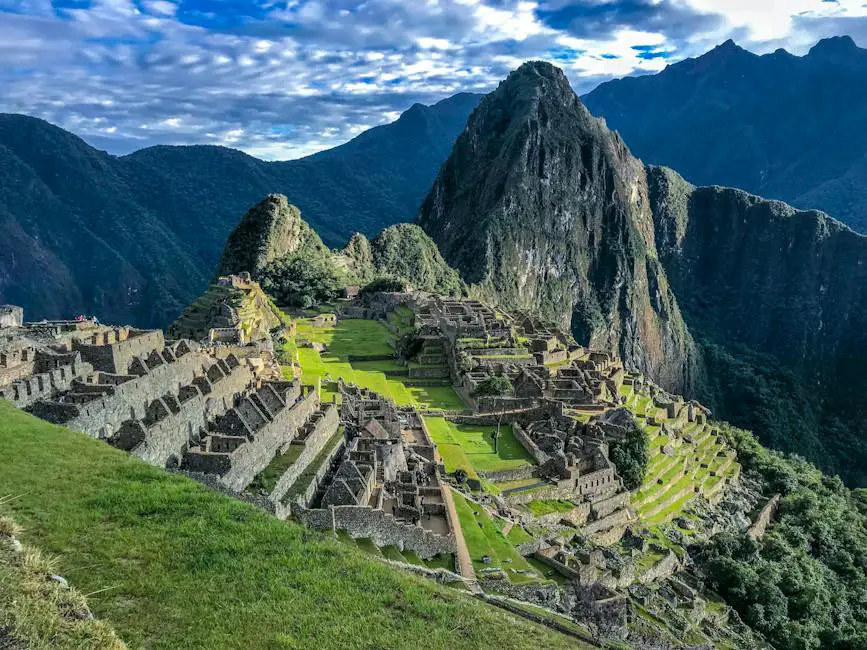
Nestled high in the Andean mountains, Cusco, Peru, is a city that’s like a living museum. Its architecture is a vivid tapestry that weaves together a story of civilizations, conquests, and cultural fusion. As you stroll through the cobbled streets, you can’t help but feel the pulse of history with every step. The city’s parks, like the Plaza de Armas, are no exception, showcasing a blend of Inca foundations topped with colonial Spanish structures.
The Inca Empire: Foundations of Greatness
The tale of Cusco’s architecture begins with the mighty Inca Empire. Their mastery of stone was unparalleled, and it’s still on display in the city’s oldest parks and structures. The Incas had a knack for integrating their buildings with the natural landscape, and their stonework was so precise that even without mortar, the stones have stood the test of time.
Take Sacsayhuamán, for example. It’s a fortress that’s as much a part of the mountain as the rocks it’s hewn from. The Incas’ understanding of their environment allowed them to create structures that have endured earthquakes while later constructions have crumbled.
Spanish Conquest: A New Layer
When the Spanish arrived in the 16th century, they were astounded by Inca architecture. Yet, they imposed their own European styles, erecting churches and mansions atop Inca foundations. This melding of styles created a unique architectural hybrid that defines Cusco today.
The Plaza de Armas, once the heart of the Inca capital, was transformed into a colonial square. The Spanish built ornate cathedrals and government buildings, which now stand as a testament to the city’s colonial past. The juxtaposition of Inca and Spanish design in these parks and buildings creates a visual narrative of Cusco’s complex history.
Earthquakes and Restoration: Resilience in Stone
Cusco is no stranger to earthquakes, which have shaped its architectural evolution. The Inca structures, with their trapezoidal doors and windows, have withstood these tremors. In contrast, the colonial buildings have often needed restoration.
After each quake, Cusco has risen, rebuilding its damaged structures. This cycle of destruction and restoration has left its mark, with each iteration adding a new layer to the city’s architectural story. The parks, too, have been reshaped, with modern restorations paying homage to both Inca and colonial styles.
Modern Influences: Blending the Old with the New
In recent years, Cusco has seen a new wave of architectural influences. Contemporary buildings are rising, incorporating glass and steel into the cityscape. Yet, these modern structures are designed with a deep respect for the past, often featuring elements that echo the Inca and colonial styles.
Even in the parks, modern landscaping techniques are used to highlight ancient stonework, creating spaces that are both functional and steeped in history. The city’s commitment to preserving its architectural heritage while embracing the new ensures that Cusco remains a dynamic, living city.
FAQs
- How has Inca architecture influenced modern construction in Cusco?
Inca architecture’s emphasis on durability and harmony with nature has inspired modern construction in Cusco. Builders often use local materials and incorporate traditional designs to maintain the city’s historic aesthetic.
- Can you see the blend of Inca and Spanish architecture in Cusco’s parks?
Absolutely! Cusco’s parks, like the Plaza de Armas, showcase this blend. You’ll find Inca walls serving as the foundation for Spanish colonial arches and facades.
- Are there any efforts to preserve Cusco’s architectural heritage?
Yes, there are numerous preservation efforts. UNESCO has designated Cusco as a World Heritage Site, and both local and international organizations work to maintain and restore its historic buildings and parks.
Conclusion
In conclusion, Cusco’s architecture is a living chronicle of its past. From the robust walls of the Incas to the ornate balconies of the Spanish, each layer tells a story of resilience and transformation. The city’s parks, with their harmonious blend of ancient and colonial designs, are open-air galleries that invite both contemplation and Celebration of Cusco’s rich heritage.
As we’ve explored, the evolution of Cusco’s architecture is not just about buildings; it’s about the spirit of a place that has adapted, survived, and thrived through centuries of change. For those looking to experience a tangible connection to history, Cusco’s parks and architecture offer an unparalleled journey from past to present.
Whether you’re a history buff, an architecture enthusiast, or simply someone who appreciates beauty, Cusco’s unique blend of Inca and Spanish design, set against the backdrop of the Andes, is sure to captivate your heart and imagination. So, let’s keep exploring, learning, and marveling at the wonders of Cusco’s architectural tapestry.